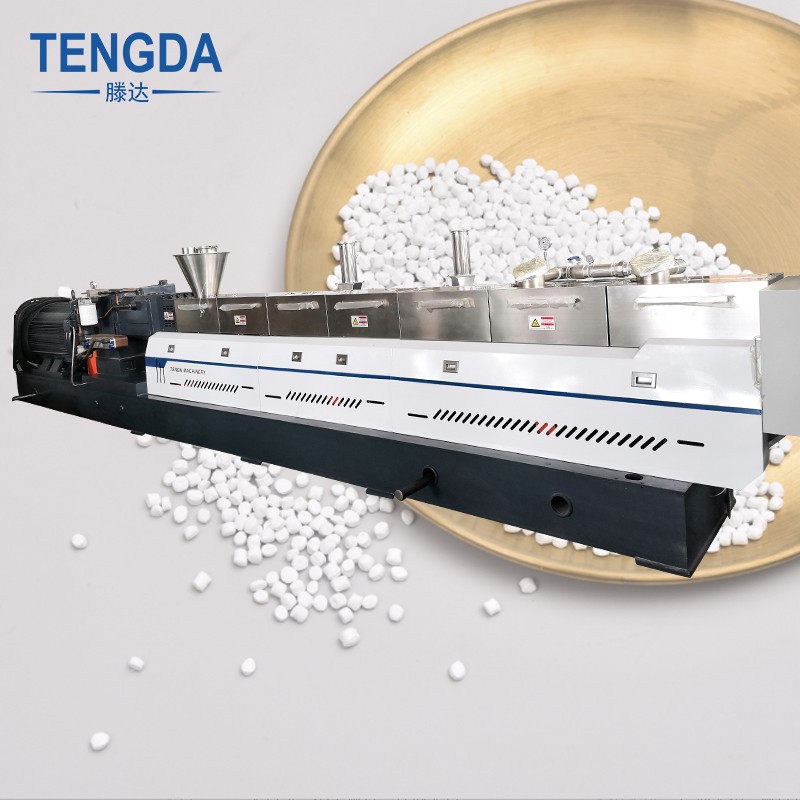Thermoplastic elastomers (TPEs), sometimes called thermoplastic rubbers (TPRs), are a class of copolymers or physical blends of polymers (usually plastic and rubber) consisting of materials with thermoplastic and elastomeric properties.
While most elastomers are thermosets, thermoplastics are relatively easy to use in manufacturing, such as by injection molding. Thermoplastic elastomers show the typical advantages of both rubber and plastic materials.
Tengda is committed to providing high quality twin-screw extruders for various TPE pelletizing (TPE / TPV / TPU / TPA). We hereby share some experiences for the following special applications.

Top 6 Common Thermoplastic Elastomers
• Styrene block copolymers, TPS (TPE-s)
• Thermoplastic polyolefin elastomer, TPO (TPE-o)
• Thermoplastic vulcanized rubber, TPV (TPE-v or TPV)
• Thermoplastic Polyurethane, TPU (TPU)
• Thermoplastic copolyester, TPC (TPE-E)
• Thermoplastic Polyamide, TPA (TPE-A)
Thermoplastic elastomer applications
• Automobiles (dust covers, triangular windows, air filters, hand brakes, etc.)
• Wires and cables (wires, ignition cables, headphone cables, connector plugs, etc.)
• Construction and transportation (seals, expansion joints, subway mats, etc.)
• Other industries (drains, handles, coasters, foot mats, shoes, etc.)
Experience in some special industry applications
1. Thermoplastic vulcanized rubber, TPV
TPV is a thermoplastic dynamically fully vulcanized rubber, which is made by dynamically vulcanizing rubber in a molten plastic phase. In this process, the rubber is sheared into micron-sized vulcanized rubber particles, forming a rubber-plastic two-phase system with a sea island structure. The two-phase system allows the TPV material to acquire the properties of both rubber and plastic, such as thermoplastic processability, full recyclability and high resilience. This product can replace rubber, save energy and is more environmentally friendly.
Due to the raw material it is produced from, the co-blending and pelletizing of TPV requires two steps, each of which requires the use of different twin-screw extruders.
If EDPM is in pellet form
1) Step 1: Pre-mixing, co-blending and oil absorption by twin-screw extruder
special screw elements are required to pre-mix the liquid and polymer.
Water ring pelletizing is sufficient.
The use of one large twin-screw extruder in the first step is sufficient to provide the raw material for several smaller extruders machine in the second step.
Base formulation:
PP (20-30%), granular EDPM (40-50%), calcium carbonate (10-20%), oil (0-15%), functional additives (2-10%).
2) Step 2: Reactive compounding with twin-screw extruder
(a) Long L/D and high torque twin-screw extruder gearboxes are required to obtain adequate reaction time, adequate dispersion.
Smaller extruders with smaller clearances are key to the process.
special extrusion screw elements are required to pre-mix the liquid and polymer.
for this step of reactive compounding with twin-screw extruder, premixing and volumetric feeding are sufficient.
Depending on the hardness of the final pellets, we can choose between water ring pelletizing or underwater pelletizing systems.
Base formulation:
Pellets made with the first step of the process, vulcanizing agent, additional oil, other additives.
If EDPM is in block form
1) Step 1: Pre-mixing with CaCO3 and absorption of all oils in the compactor
Subsequently, the material is force fed into a single screw extruder for pelletizing or crushing into small pieces.
Base formulation:
Block EDPM, calcium carbonate (10-20%), oil (0-30%), functional masterbatch (2-10%).

2) Step 2: Reactive compounding with twin-screw extruder
Need for long L/D and high torque twin-screw extruder gearboxes to obtain adequate reaction time, adequate dispersion.
Special screw elements of twin-screw extruder are required to premix the liquid and polymer.
for this step of the process, loss-in-weight of twin-screw extruder scale feeding is better.
Depending on the hardness of the final pellets, we can choose between water ring pelletizing or underwater pelletizing systems.
Base formulation:
PP, pelletized raw material prepared in the first step, vulcanizing agent, other functional additives.
2. Pelletizing of TPR for shoes
the choice of using a twin-screw extruder allows for higher throughput and better dispersion of the product compared to the conventional process (dense refiner + single extruder).
Color can be easily changed.
Water ring pelletizing.
Base formulation:
HIPS/CPPS + SBS + paraffin oil + calcium carbonate + silicon dioxide + EVA + stabilizer + functional masterbatch